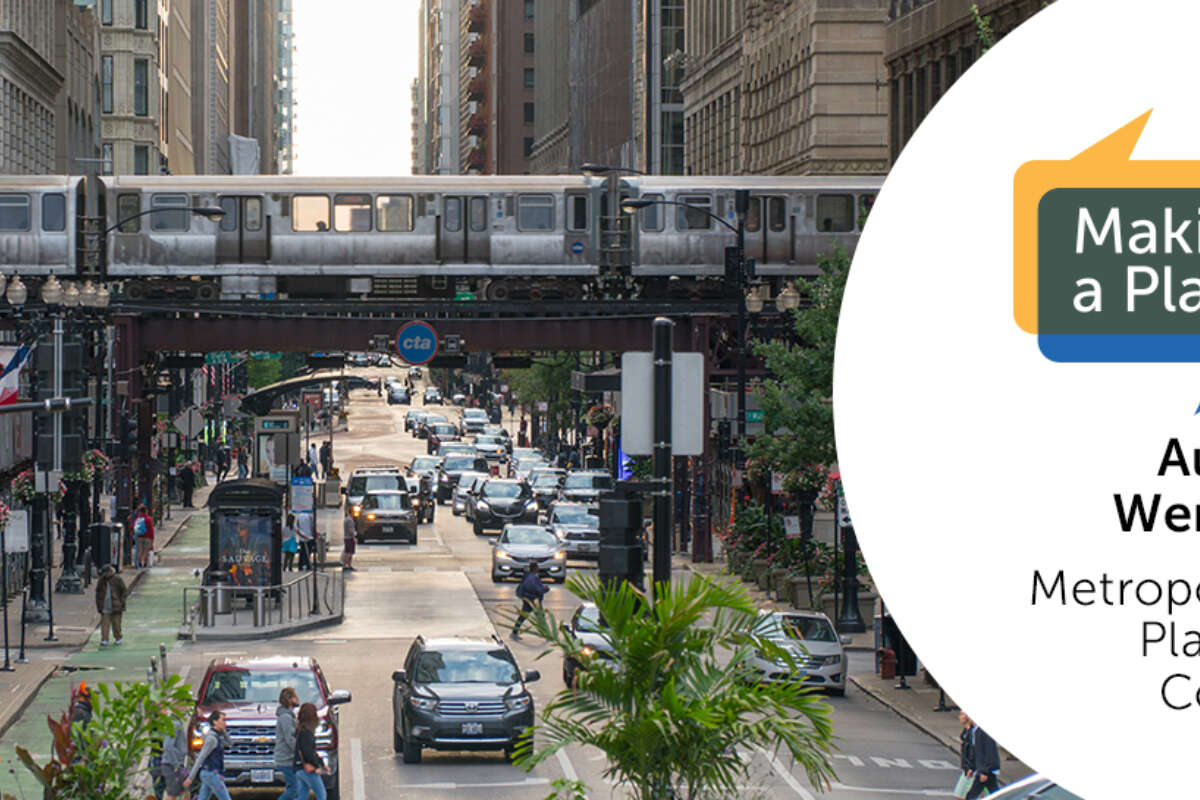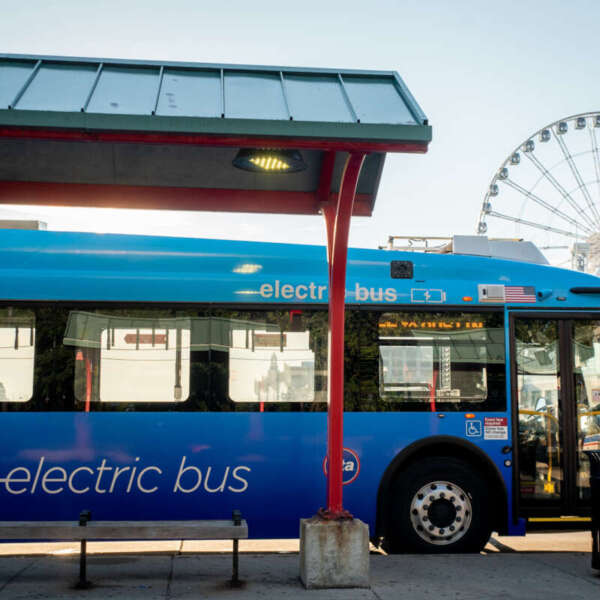Guest blogger Audrey Wennink from MPC says transit can be a public health, equity solution
November 10, 2021
November 10, 2021


The RTA is currently developing the 2023 Regional Transit Strategic Plan for Northeastern Illinois at a time when the challenges and opportunities facing our region’s transit system have never been greater. Making a Plan represents our effort to engage and collaborate with close stakeholders and the public. We have invited a group of transit users and thinkers to answer a set of questions for an occasional guest series on Connections, the RTA blog. The views represented in this series are not those of the RTA, but they are views we want to hear and have heard. If you have thoughts about this post, the strategic plan, or would like to participate by contributing a guest blog post, please email communications@rtachicago.org and subscribe to our newsletter to learn more.
Name: Audrey Wennink
Organization or Affiliation: Metropolitan Planning Council (MPC)
Role/Responsibilities: Director of Transportation
Favorite transit mode or station?
Belmont rail station because there you can connect to 3 lines, it’s ADA accessible, public art in the station is excellent, there is tons of great retail nearby, and there are some lovely urban views off the platform. For my 15th wedding anniversary we chartered a CTA train for a private party and it was one of the highlights of my life in Chicago.
Why are you passionate about transit?
Transit is affordable, equitable, environmentally friendly transportation that enables large regions like greater Chicago to exist. It’s also a community builder. Public transit provides a shared public space where people from a wide range of backgrounds and communities interact.
What do you see as the greatest challenges and opportunities for the Chicago region’s transit system over the next ten years? What is the biggest barrier to realizing these opportunities?
Transit ridership has been declining in the region for the past 9 years. And COVID dealt it an additional serious blow. We need to provide service that meets people’s needs today. It is critical to create an environment that is friendly, safe, and appealing so that people increasingly choose to use transit. Since the majority of transit riders are women, our transit providers should conduct research like Metro Los Angeles’s Understanding How Women Travel report to understand the many dimensions of what makes transit attractive. We need to continue to develop a customer-centered approach to providing transit. MPC and other Transportation Equity Network advocates are in favor of initiating a Transit Ambassadors program, which would provide uniformed, unarmed personnel trained in social services, de-escalation, and assisting people with disabilities. They would help provide a safe, welcoming presence and help people to ride our extensive transit system.
Tell us your ideas for improving access to transit within the Chicago region and what policy levers or partnerships might be required to make the changes you envision?
Access to transit starts in transit station areas. We need to make our transit station areas safe, appealing places to walk, bike and just be. We need to step up focus on prioritizing the walkability of station areas and ensure protected bike lanes connect to them. We need to integrate public art and programming -- like public markets -- to make station areas into hubs of positive activity where people want to go.
Related to this is making sure that there are many places people can live and work near transit. We need to reverse the trends of our region’s housing and jobs sprawling away from our transit systems. We need to proactively be developing affordable housing and encouraging employers to locate along the transit system. This takes a range of partnerships including with municipal leaders who manage zoning and can encourage denser development in station areas. It also involves state, city and county transportation staff and municipalities that build and maintain the sidewalks near rail stations and bus stops.
Elevated Chicago is a great example of efforts in Chicago to partner with community organizations on developing equitable transit oriented development (ETOD) and engaging community residents in improving station areas.
Decades of underfunding have left the transit system in a constant state of austerity. Tradeoffs are almost always necessary when making decisions about improvement and expansion of the system. How do you recommend investing in the system to achieve the greatest regional impact?
Transit is one of the top public health solutions. The Centers for Disease Control has studied investments that can generate short term results through its Health Impact in 5 Years Program and Public Transportation expansion was identified as one of the top interventions. We need to invest in transit as a means to achieve public health outcomes because people who use transit integrate more physical activity into their days. And public transportation services play an important role in meeting daily needs for the many people who are unable to drive, including those without access to personal vehicles, children, individuals with disabilities, and older adults.
Climate change should be motivating intense support for transit. The transportation sector is the top contributor to GHG emissions. The more that people choose transit over driving, the faster we can decarbonize our transportation sector. Additionally, transit systems are shown to create more walkable communities where people drive less, which also reduces transportation emissions. We need to fund transit as a climate solution.
What models of successful transit funding can we look to for guidance as we seek to make our funding streams more sustainable?
We need to rely less on fares to fund transit operations. In Illinois, to do this we’ll need to make some changes in state legislation to lower the mandated “farebox recovery ratio.” To accelerate the positive health, equity and climate outcomes that we all want, we should be directing Federal, state and municipal resources to support transit operations.
We are going to need to toll more of our roads in the future to manage demand for driving and pay for roadway maintenance, and we must ensure that a significant share of those revenues go to transit so that people have affordable travel options. Toll revenue collected from cars and trucks should be used to support transit operations, including express buses on highways, so that we have truly multimodal corridors where people have sustainable and affordable transportation choices.
The role of transit as the irreplaceable piece of our mobility system has been underscored by this pandemic. Data and survey results have shown how much essential workers, low-income riders, and residents of color have relied on it over the past year and a half especially. How has the pandemic changed or clarified your views on the role and future of public transit?
Transit has major equity impacts – In Chicago more than ¼ of households do not have a car, and at the regional level about 13 percent of households do not have a vehicle. Nationally, communities of color make up the majority of transit riders. Making sure people have affordable and convenient transportation options other than driving to meet their daily needs is critical. When we make transit better, we increase the access to opportunity for those who need it most.
Regional mobility impacts everyone but is competing for attention among many worthy public policy issues. What in your experience has been the most successful way to engage people about transit issues?
We need to rethink how we develop transportation solutions. We need to start with the transit riders and ask them what they need. Many times, solutions are not “megaprojects” that will take decades to fund and build. People need solutions now. What can we do now, so transit gets people where they need to, when they need to, and to make it more affordable, safe, and enjoyable? Solutions may involve discounts to fares, improving feelings of safety on transit, speeding up bus service and increasing access to stations. Maybe what we need most is to increase the hours of service for riders, so that transit is a viable option for those who work nontraditional hours. We need to engage people early on and ask broad questions about what they need, not engage communities only when a major project has been identified, that maybe they don’t even feel will help solve their problems. We need to understand people’s lived experience as the most important data point. We must be prepared to devise solutions that may require pilots, innovation, and iteration, and gather people’s input all along the way.
Subscribe to our Newsletter
Related Articles
 New stations on CTA Green Line, Metra UP-N line increase transit access for residents, riders
New stations on CTA Green Line, Metra UP-N line increase transit access for residents, riders
In 2024, CTA and Metra opened two new stations: the Damen station in Chicago’s Near West Side neighborhood along CTA’s Green Line and the Peterson/Ridge stat...
January 28, 2025 2025 Regional transit budget available for public comment, foreshadows risk to system’s future without fiscal cliff solution
2025 Regional transit budget available for public comment, foreshadows risk to system’s future without fiscal cliff solution
The RTA has released the 2025 Regional Transit Operating Budget and Five-Year Capital Program for download and public comment. The budget comes as an operati...
November 15, 2024 With equity at the forefront, CTA, Metra, and Pace open new facilities, prioritize upgrades in south and west communities
With equity at the forefront, CTA, Metra, and Pace open new facilities, prioritize upgrades in south and west communities
This year, CTA and Pace have opened or advanced various new facilities in south and west communities throughout the region, and Metra has prioritized upgrade...
October 9, 2024 New project management oversight report highlights more than 100 projects representing $8.2 billion in capital investments
New project management oversight report highlights more than 100 projects representing $8.2 billion in capital investments
The RTA’s Project Management Oversight (PMO) program ensures that the Service Boards—CTA, Metra, and Pace—are spending capital funds and managing their infra...
June 27, 2024 Transportation Tuesday recap: Improving and expanding the transit system strategically
Transportation Tuesday recap: Improving and expanding the transit system strategically
With last year’s adoption of Transit is the Answer came 15 new evaluation metrics that comprise a strategy for evaluating and selecting capital projects. Now...
May 30, 2024 Transit is the answer to meeting Illinois’ climate goals
Transit is the answer to meeting Illinois’ climate goals
As we celebrate Earth Day 2024, the RTA is announcing Transforming Transit —the agency’s commitment to lead the Chicago region’s transit system into the futu...
April 18, 2024